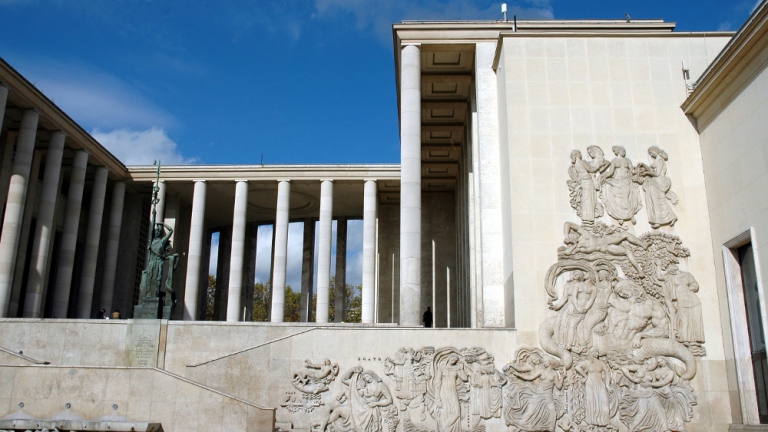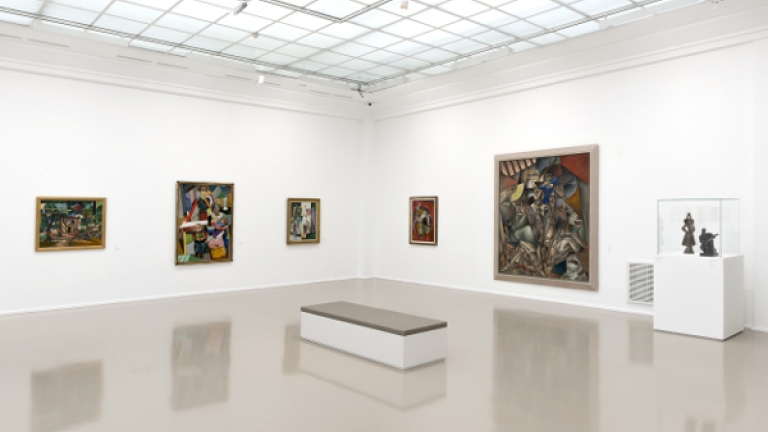One venue, one collection
Located between the Champs-Elysées and the Eiffel Tower, the palace that houses the Musée d’Art Moderne de la Ville de Paris is a magnificent example of 1930s architecture. It is unquestionably one of the key institutions of Parisian cultural life. The Museum’s collection of more than 13,000 works makes it one of the biggest museums of modern and contemporary art in France.
The permanent collections present all the main artistic trends from the beginning of the 20th century up to the present day, and include major artists from those periods, such as Picasso, Dufy, Modigliani, Derain, Picabia, Chagall, as well as Boltanski, Parreno and Peter Doig. The museum also owns rare and exceptional in situ works, such as the first two versions of La Danse by Matisse and Raoul Dufy’s monumental masterpiece La Fée électricité.
One building for two museums
The Museums of Modern Art – one belonging to the city of Paris; the other state-owned – were created at the time of the 1937 Exposition Universelle.
For a long time, the City of Paris, had been wanting to split off part of the collections in the Musée du Petit Palais in order to create a museum of modern art that would specialise in 20th-century art. The same idea had been entertained by the state regarding the Musée du Luxembourg and the Jeu de Paume. This gave rise to the joint project of the Palais de Tokyo.
The architectural competition, launched in 1934, was won by a team of two young architects, Jean-Claude Dondel and André Aubert, supported by two experienced architects, Paul Viard and Marcel Dastugue. The Palais de Tokyo was built in 1937. It has two large wings, perpendicular to the Seine. The wings have smooth, simple lines and are connected by a portico in the form of a pillared arcade opening onto terraces and steps going down to the river. This elegant building combines classical and modern elements. The architectural decoration is all on the outside. The interior of the building was intentionally kept unadorned. The sculpture, which has a mythological theme in keeping with the function of the building, is focused on the figure of Apollo Musagetes (god of the arts), surrounded by centaurs and nymphs.
The French state created the Musée d'Art Moderne National here in 1947, before transferring it to the Pompidou Centre in 1977, while the City of Paris created the Musée d'Art Moderne here in 1961.

A Collection on the move
Since its beginnings, donators, collectors and artists have been essential factors in the Museum’s growth.
The backbone of the present collection is the result of an exceptional legacy of more than 500 works from Doctor Maurice Girardin, which included many Fauvist paintings by Lhote, Derain , Matisse, Braque, Dufy, Lipchitz, and Vlaminck, as well as a large number of Cubist works and works by artists such as Rouault (109), Soutine, Modigliani and Buffet (13 works). The arrival of this bequest was a determining factor for the Parisian authorities in their decision to leave the confines of the now too small Petit Palais and to open a dedicated venue in the Palais de Tokyo.
In 1954, the French state electricity company, Électricité de France, donated Raoul Dufy’s huge mural La Fée Électricité to the Museum. The artist had wanted the company to make the donation in time for it to be displayed when the new Museum opened. The work was displayed for the first time in 1964, after radical alterations to the building to enable the 250 panels to be fixed on 600 m² of wall in a horseshoe-shaped room.
The Amos (1955) and Henry-Thomas (1976, 1984, 1986) donations were also decisive contributions to the Museum’s identity. In 1937, the City of Paris had acquired a number of major works by Matisse, Bonnard, Delaunay, Derain, Léger, Lhote, and Vuillard as well as items of furniture by Chareau, Arbus, and Ruhlmann. These are just some of the masterpieces that still grace the Museum, along with large-scale murals by Robert and Sonia Delaunay, Albert Gleizes and Jacques Villon, which were acquired in 1939 as a gift from the Salon des Réalités Nouvelles. The Museum’s policy of developing the collections has continued unabated ever since. More than 800 works have come into the collections since 2007, thanks particularly to the Chirico bequest (2011), the Michael Werner donation (2012), and the dynamic acquisitions policy of the Friends of the Museum (Société des Amis du musée), which has seen works by Peter Doig, Christopher Wool, Douglas Gordon, Philippe Parreno, Gilles Barbier, and Sturtevant enter the Museum’s collections.
In 2014 Otto Freundlich’s great masterpiece Composition 1911, recognised as a major heritage work, entered the Museum’s collections.


